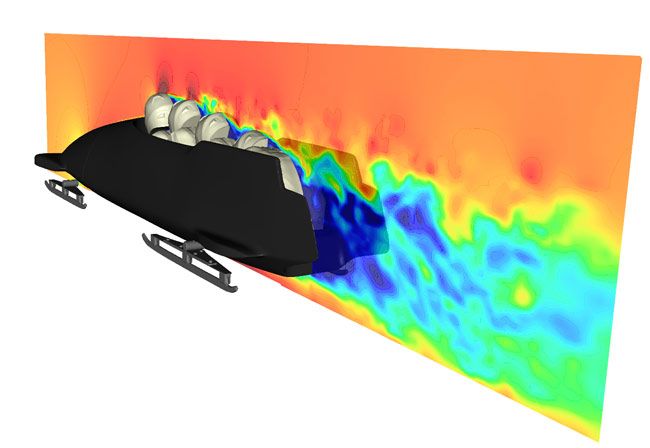U.S. Bobsled Team Gets High-Tech Edge

In Olympic bobsledding, hundredths of a second can mean the difference between winning and losing.
For the Vancouver Winter Olympics, the U.S. team might be just that much faster thanks to new sled designs based on complex models of airflow and turbulence.
The team has been working with the Exa Corporation, based in Burlington, Mass., which designed computer simulations to study how air travels around bobsleds, and how that airflow could be improved to speed up their races. Based on these models, the scientists came up with a new aerodynamic bobsled design to give the team an edge on the ice in Vancouver.
Olympic bobsledding involves teams of two or four people racing down a steep and twisted track in partially-enclosed fiberglass sleds attached to steel runners. Teams from 24 countries will enter the competition this year.
The scientists used a technique called computational fluid dynamics to simulate the physics of air flowing around bobsleds. Their 3-D models built up the approximate form of a bobsled out of very small triangle shapes, which could be adjusted to alter the sled's shape. They then immersed their simulated sled into a 3-D environment filled with tiny air particles, and let the computer calculate how those particles would move around the sled as it raced down a course.
The engineers tested tiny tweaks to the bobsled's shape over many trials to find the optimal sled design that would produce the least air resistance for the fastest possible run.
"The aerodynamic efficiency only needs to change by a fraction of a percent in order to have a big impact on the outcome," said Brad Duncan, director of aerodynamics applications at Exa. "Because you're talking about tiny fractions of a percent, any improvement, no matter how small, is enough to give you a competitive advantage."
Sign up for the Live Science daily newsletter now
Get the world’s most fascinating discoveries delivered straight to your inbox.
Some of the tweaks helped diminish the air resistance that builds up against the front of the sled as it slices through the air, creating a buildup of elevated pressure that pushes back on its leading end.
But the team found even more improvement in the back area of the sled, which creates a wake of lower air pressure behind it that exerts a pulling force, tugging the sled slightly backward.
"You've got high pressure on the front, and low pressure behind you that's also pulling you back and creating wind resistance," Duncan said. "So you want to try to get that wake from pulling back as much. That’s where we found a lot of the benefits from our redesign."
The back wake proved to be very complicated, with extremely turbulent airflow that was dynamic and hard to predict.
"We tested many ideas that failed," Duncan told LiveScience, though they managed to find a few that worked, too. It helped that their computer models could be run over and over to monitor the different outcomes resulting from minute changes.
"We've heard that some other countries are using more traditional processes where they do testing in wind tunnels," Duncan said. "That’s where the U.S. team was able to leapfrog the competition, was to do digital testing."
The engineers are eager to see how their redesigned sled performs in its first Olympic run, but they know the real outcome will depend on the athletes.
"I'm definitely hoping that everything goes well with the crew, because I know they’ve got the right hardware," Duncan said.
{{ video="LS_100212_bobsled" title="" caption="" }}
- Quiz: Test Your Olympic Knowledge
- Video - Bobsled Physics
- How the Olympics Changed the World












